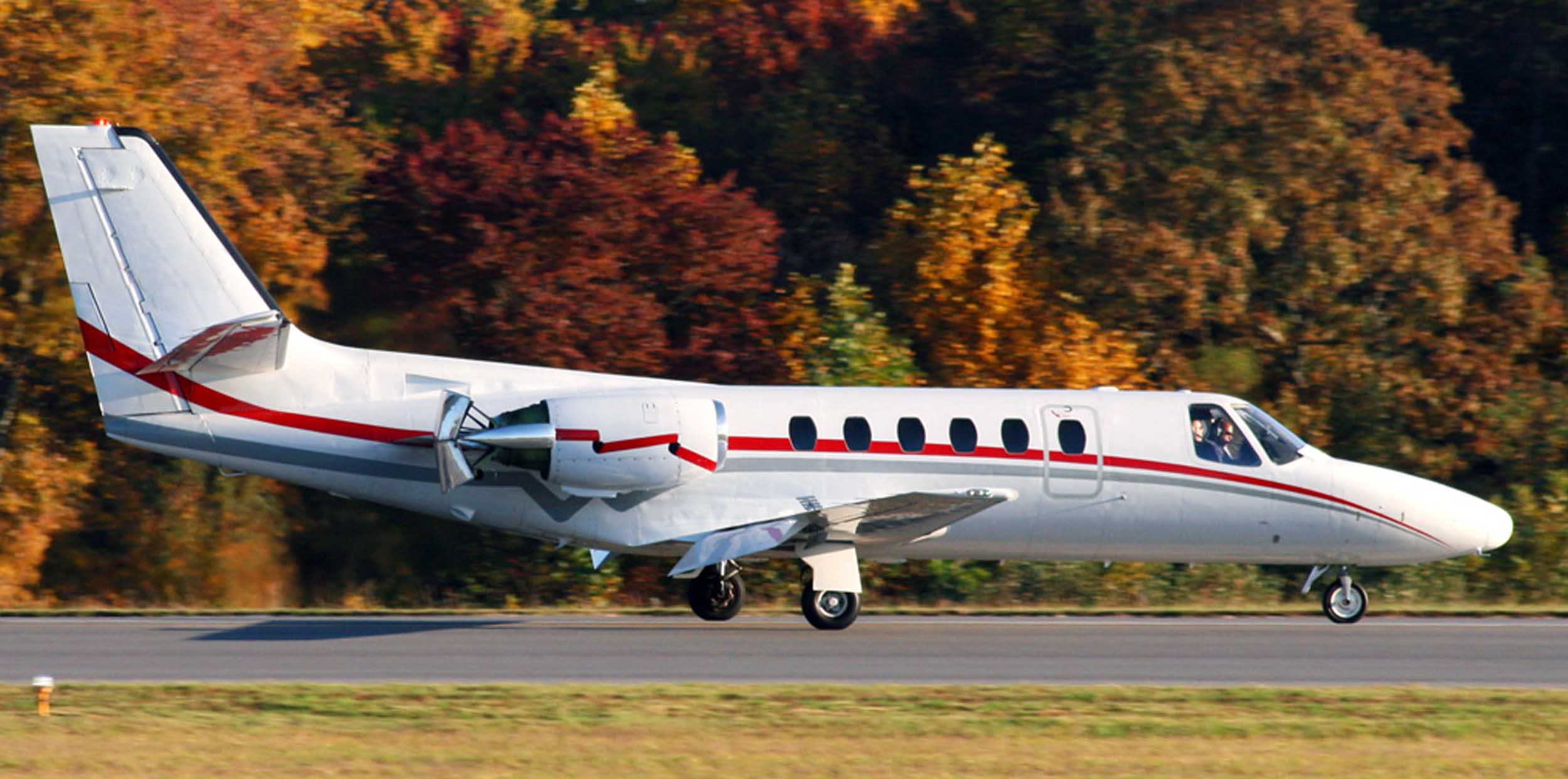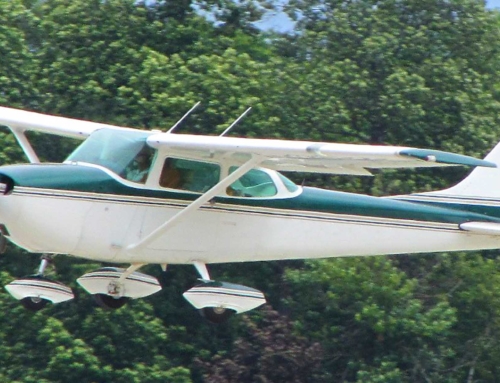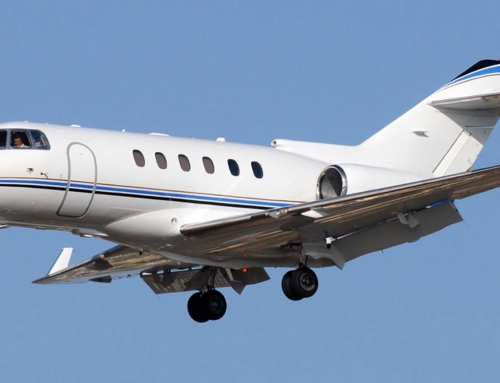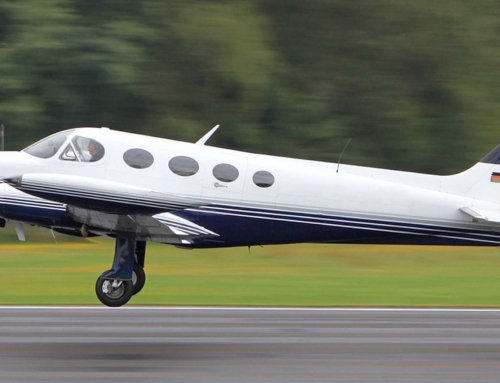The Cessna legacy first started in June 1911 when Founder Clyde Cessna built and flew a powered aircraft. At the time, his only background was in farm machinery and developing new farming methods.
So how did he get into aviation? He was inspired after viewing a 1910 aerial exhibition, leading him to experiment with his own aircraft designs in Enid, Oklahoma. Financial difficulties sent him home to Wichita, Kansas where he co-founded Travel Air Manufacturing Co. in 1924. In 1927, Clyde left to start the Cessna Aircraft Company where he debuted his successful monoplane designs.
Unfortunately, the Great Depression forced Cessna to close its doors in 1931. But Clyde’s advancement in aviation didn’t stop there. He eventually co-founded C.V. Cessna Aircraft Co. with his son, Eldon.
Shortly after the launch of C.V. Cessna Aircraft Co., Clyde’s close friend, lost his life in a plane crash. This drove him to leave the aviation industry entirely. Thankfully for the continuity of C.V. Cessna Aircraft Co., Clyde’s nephew, Dwane Wallace, revived the company in 1934.
The Citation Bravo’s Hold On A Strong Resale Market
While Cessna has a successful history of aircraft, its Cessna Bravo is best known as a popular business jet. Its reliability, comfort, and efficiency not only make it a favored choice for private jet charter and ownership but also support a strong resale position.
Since the Citation Bravo’s introduction in 1997, initial marketing for this brand new business jet leans on the elevated and luxurious experience – “it’s a lot more airplane than even the most popular business jet ever built”. Compared to its predecessor, it:
- Cruises at 460 mph
- Climbs to altitude quicker
- Has better fuel efficiency
- Contains advanced cockpit technology
- Has lower operating costs
- Facilitates smoother landings
- Improves payload
In all the early marketing, Cessna combines its advancements with financial savviness. If you’re looking for a business jet with a strong resale market, the Citation Bravo may be for you.
- Country of Origin: America
Cessna Citation Bravo 550 Statistics
- Maximum Speed: 400 kts
- Maximum Range: 1,658 nm
- Maximum Occupants: 11
- Range Of Years Manufactured: 1997-2006
- Total Aircraft Build: 337
- Current Operational Aircraft: About 333
- Useful Load: 5,500 lbs
- Average Sale Value: $2.18 million
- Average Days On Market For Sale: 334
- VREF Demand Rating: Normal
Operational Resources
Local Resources
- Textron Aviation Inc. (Domestic and International Service Centers)
- Cessna Flyer Association
Manufacturer
Insurance
- Avemco
- AOPA Insurance
- BWI Aviation Insurance
- Falcon Aviation Insurance
- Travers Aviation Insurance
- USAA Aircraft Insurance For Pilots
Cessna Citation Bravo 550 Details
Interior
The Cessna Citation Bravo 550 provides 278 cubic feet of space. Typically configured to seat 7 passengers and 2 crew members, the cabin is designed for comfort and incorporates bagged insulation and an isolated interior shell to minimize low-frequency engine noise.
Exterior
The Cessna Citation Bravo 550 is equipped with a trailing link main undercarriage to enhance landing smoothness. This aircraft is powered by 2 Pratt & Whitney Canada PW530A engines that each deliver 2,887 pounds of thrust contributing to its reliable performance.
Avionics
- Avionics: Honeywell Primus 1000 3 Displays
- Air Data Computer: Dual Honeywell AZ-850 Flight Data Computers
- Cockpit Voice Recorder: Fairchild Solid State CVR (30 minutes)
- Communications: Dual BendixKing VHF-COMM KY-196B Transceivers
- Distance Measuring Equipment: Dual BendixKing KDI-572 DMEs
- Emergency Locator Transmitter: Artex ELT-110-4
- Flight Management Systems: Universal UNS-1L Flight Management System
- High-Frequency Radio: BendixKing KHF-950 HF Radio
- Radio Altimeter: Honeywell AA-300
- Navigation: Dual BendixKing KN-53 Nav Receivers
- Selcal: Coltech CSD-10 SELCAL
- Terrain Awareness Warning System: Honeywell EGPWS with Terrain Awareness Display
- Traffic Collision Avoidance System: BendixKing CAS66A (TCAS I with Change 7)
- Transponders: Dual King KT-70 Mode S Transponders
- Weather Radar: Honeywell WU-660
Specifications
- Max Takeoff Weight: 14,800 lbs.
- Configuration: Twin Engine Fanjet Engine
- Max Seats: 11
- Cruise: 400 kts
- Range: 1,658 nm
- Takeoff Balanced Field Length: 3,600 ft.
- Wing Span: 52 ft. 3 in.
- Length: 47 ft. 3 in.
- Height: 15 ft.
Cessna Citation Models
The following includes all Cessna Citation Bravo 550 variants:
Cessna Citation Ascend 560XL
Introduced in 2025, the Ascend joins the 560XL series – the most flown series in the Citation family. It’s best known for its advanced avionics – including the Garmin G5000 – and luxurious cabin space. It has a maximum range of 2,100 nautical miles, a cruise speed of 411 knots, and the power to climb to 45,000 feet. The Ascend can be configured to accommodate up to 12 passengers.
Cessna Citation Bravo 550
The Bravo 550 was first flown in 1995 and was introduced 2 years later in 1997. Powered by PW530A engines, the Bravo generates 15% more thrust at takeoff and 23% more thrust at altitude. Production stopped in 2006 where it was replaced by the Citation CJ3.
Cessna Citation Encore + 560
Known for being one of the largest straight-wing members of the Citation series, the Encore+ is powered by 2 PW535B engines. It is equipped with a Collins Pro Line 21 avionics system. Because of its lighter weight, it has an improved payload capability. The Encore+ also has an increased wing length that boosts high-altitude flying.
Cessna Citation Encore 560
The Citation Encore is an upgraded version of the Citation Ultra. It is powered by PW535 turbofans and was introduced in 1998. The Encore has a maximum cruise of 420 knots and a range of 1,577 nautical miles.
Cessna Citation Excel 560XL
First flown on February 29, 1996 and certified by April 1998, the Citation Excel 560XL embodies power and precision with the high performing and fuel efficient twin Pratt & Whitney PW535A turbofans. It has the unique cruciform tail design of the Citation V (560) with an aerodynamic upswept supercritical wing. The cabin is slightly more compact than other Citation aircraft, drawing inspiration from the Citation X.
Cessna Citation I 500
This variation is the basis for the entire Citation aircraft family. First flown on September 15, 1969, it was certified on September 9, 1971. Production ended in 1985. Its straight wing design was then developed into the Citation II/Bravo variants.
Cessna Citation II 550
This light corporate jet was announced in September 1976, first flew on January 31, 1977, was certified in March 1978. Production ended in 2006.
Cessna Citation III 650
Introduced in October 1976, this business jet received its certification on April 30, 1982. It was delivered between 1983 and 1992. The III featured an all-new design, including a 312 square foot swept wing for a 22,000 pounds maximum takeoff weight, a T-tail, and 2 Honeywell TFE731 turbofans. The fuselage cross-section and cockpit were later reused in the Citation X, Citation Excel, and Citation Sovereign.
Cessna Citation IISP 551
The Cessna Citation IISP 551 is a stretched version of the Citation I. It was first announced in September 1976, first flew on January 31, 1977, and then was certified in March 1978. The IISP has a maximum range of 1,520 nautical miles and a maximum speed of 355 knots. Production ended in 2006.
Cessna Citation ISP 501
This single-pilot variant was introduced in 1977. Production ended in 1985. The Citation ISP 501 was then developed into the Citation II.
Cessna Citationjet CJ 525
Introduced in October 1989, the Cessna Citationjet CJ 525 took its first flight on April 29, 1991. It was certified on October 16, 1992, and was delivered a couple of months later on March 30, 1993. This aircraft is powered by twin Williams FJ44 engines, includes the Citation II’s forward fuselage, and has a redesigned carry-through section, straight wing, and T-tail.
Cessna CitationJet CJ1 525
The next generation of the Cessna CitationJet was introduced in 2000 as a light business jet, known for its efficiency and performance. It has a maximum range of 1,300 nautical miles, a cruising speed of 400 knots, and is powered by Williams FJ44 engines. With a capacity of 8, it’s ideal for both short and medium-haul flights. Both experienced and novice pilots like flying this aircraft due to its user-friendly cockpit and advanced avionics.
Cessna CitationJet CJ1+ 525
In 2005, Cessna launched an enhanced variant of the CJ1 that offers upgraded performance due to its advanced avionics. Slightly smaller, the space for up to 6 passengers makes it ideal for business travel. The CJ1+ is favored among light jets due to its reliability, speed, and cutting-edge technology – including the Garmin G1000 flight deck.
Cessna CitationJet CJ2 525A
Debuted in 2002, the Cessna CitationJet CJ2 features a larger cabin than the CJ1 and accommodates 8 passengers comfortably. This versatile light jet is powered by Williams FJ44-2A engines, enhancing its overall performance. It has a max range of 1,500 nautical miles and cruises at 400 knots. What sets this aircraft apart is its advanced avionics making it suitable for various flight conditions while its spacious cabin makes it ideal for either business or leisure travel.
Cessna CitationJet CJ2+ 525A
Introduced in 2005, the Cessna CJ2+ 525A includes the Garmin G1000 avionics suite – enhancing both situational awareness and ease of operation. The combination of the CJ2’s impressive performance, spacious cabin, advanced technology, and increased reliability makes it an attractive choice for business travelers who prioritize efficiency and comfort.
Cessna CitationJet CJ3 525B
Known for its performance and spacious cabin, the Cessna CitationJet CJ3 – introduced in 2004 – accommodates up to eight passengers and has an increased maximum range of 2,000 nautical miles. The Williams FJ44-3A engines and advanced avionics suite, including the Pro Line 21, combine speed, range, and comfort – making it an ideal option for medium-haul flights.
Cessna CitationJet CJ3+ 525B
An enhanced version of the CJ3, the CJ3+ was launched in 2024 with upgraded avionics that provided advanced navigation and control capabilities. It maintains the same performance as the CJ3. In addition to its spacious cabin that blends comfort and functionality, business travelers seeking efficiency will also appreciate the modern technology and reliable performance the CitationJet CJ3+ offers.
Cessna CitationJet CJ4 525C
Introduced in 2010, the Cessna CitationJet CJ4 525C is by far the largest and most advanced model in this aircraft series. Slightly larger than other variations, its spacious cabin can accommodate up to ten passengers. This makes it an ideal aircraft for larger groups. Additionally, its Williams FJ44-4A engines increased its maximum range to 2,165 nautical miles and a cruising speed of 450 knots. It also included advanced avionics like the Garmin G3000 to enhance safety and operational ease. A top choice for business travelers, the CJ4 combines performance, comfort, and advanced technology.
Cessna Citation Latitude 680A
Introduced in 2011, the Latitude first flew on February 18, 2014, and was certified on June 5, 2015. It kept the Sovereign wing, the P&W PW306D turbofans, and the cruciform tail in its design. New to this aircraft, it featured a clean sheet stand-up circular fuselage. This was kept in the Longitude variant.
Cessna Citation Longitude 700
The Cessna Citation Longitude (Model 700) is a 3,500 nm range business jet bridging midsize and super-midsize categories. Announced at EBACE 2012, it first flew in 2016 and was certified in 2019. Powered by Honeywell HTF7000 turbofans, it features an aluminum airframe with a stretched Citation Latitude fuselage. Designed as a successor to the canceled Citation Columbus, it offers an eight-passenger double-club cabin. Its wings and empennage, derived from the Hawker 4000, incorporate winglets that extend the wingspan by 5.3 feet. A supercritical wing with a refined sweep improves efficiency and performance.
Cessna Citation M2 525
The Cessna Citation M2 replaced the Citation 1+ and became Textron’s entry-level jet after Mustang production ended in 2017. Based on the CJ1, it offers improved speed, range, and efficiency. Powered by Williams FJ44-1AP-21 engines, it features Garmin G3000 avionics and small winglets for enhanced performance. First flown in 2012 and certified in 2013, the M2 climbs faster, has a more comfortable cabin, and outpaces competitors like the Phenom 100E. By 2020, 250 units had been delivered. As of 2021, its equipped price was $5.575M.
Cessna Citation Mustang 510
The Cessna Citation Mustang 510 is a very light jet introduced at NBAA 2002, first flown in 2005, and certified in 2006. Powered by 2 P&W PW615F engines, it has a 1,167 nm range. Featuring a swept wing, T-tail, and retractable gear, it seats four passengers in the aft cabin with a single-pilot cockpit. Its aluminum airframe includes a three-spar wing, a main entry door, and an emergency exit. Production ended in 2017 after 479 aircraft were built.
Cessna Citation S/II S550
The Cessna Citation II 550 is a light corporate jet developed from the Citation I with a stretched airframe. Announced in September 1976, it first flew on January 31, 1977, and received certification in March 1978. The single-pilot II/SP variant followed, while the upgraded Citation S/II (Model S550), featuring an improved wing and performance enhancements, first flew on February 14, 1984. Production ended in 2006 after 1,184 aircraft were delivered with the S/II replacing the II in production.
Cessna Citation Sovereign + 680/680
The Cessna Citation Sovereign 680 is a midsize jet balancing comfort, performance, and range. Introduced in 2004, it features a high-lift wing for short-field capability, PW306C engines, and Primus Epic avionics. Seating up to 11, it cruises at 445 knots. The 2012 Sovereign+ added winglets, PW306D engines with autothrottles, a 3,000 nm range, and Garmin G5000 avionics. With enhanced cabin design and full in-flight connectivity, it remains a top midsize jet option.
Cessna Citation Sovereign 680
The Cessna Citation Sovereign 680 is a 3,200 nm range business jet developed by Cessna, part of the renowned Citation family. Building on the Citation Excel’s fuselage, it features a newly designed, larger wing and more powerful Pratt & Whitney Canada PW306C engines, boosting maximum takeoff weight and performance. Announced at the 1998 NBAA, the Sovereign made its maiden flight in February 2002, received certification on June 2, 2004, and entered service later that year. The improved Sovereign+ was introduced at the 2012 NBAA, featuring winglets, an upgraded flight deck, and enhanced engines with deliveries starting in December.
Cessna Citation Ultra 560
The Cessna Citation V 560 is an American business jet developed by Cessna, based on the Citation II airframe. A prototype flew in August 1987, with FAA certification granted on December 9, 1988. A total of 774 aircraft were delivered through 2011. The upgraded Citation Ultra, announced in September 1993 and certified in June 1994, featured more powerful JT15D5D engines and Honeywell Primus 1000 EFIS avionics, with 279 units delivered. The Citation V Ultra was named Flying magazine’s “Best Business Jet” in 1994 and remained in production until 1999.
Cessna Citation V 560
The Cessna Citation V, introduced in 1989, is a reliable and versatile business jet favored by corporate travelers. Powered by 2 Pratt & Whitney JT15D-5D engines, it offers impressive performance with a maximum cruising speed of 425 knots and a range of around 1,960 nautical miles. The cabin accommodates up to eight passengers, providing comfort for both short and medium-haul flights. With advanced avionics and a durable design, the Citation V delivers a blend of performance, luxury, and cost-effectiveness, making it a popular choice for private jet owners.
Cessna Citation VI 650
The Cessna Citation III, VI, and VII 650 are American manufactured business jets with a 2,350 nm range produced by Cessna. They are part of the classic Citation Family Announced at the October 1976 NBAA convention; it made its maiden flight on May 30, 1979, received its type certification on April 30, 198,2, and was manufactured between 1983 and 1992. The Citation VI was produced from 1991 to 1995 and the Citation VII was built between 1992 and 2000, 360 of all variants were delivered. An all new design, it had a 312 square feet swept wing for a 22,000 pound maximum takeoff weight, a T-tail and two 3,650–4,080 lbf Honeywell (Garrett Turbine) TFE731 turbofan engines. Its fuselage cross section and cockpit were used in the Citation X, Citation Excel, and Citation Sovereign.
Cessna Citation VII 650
The Cessna Citation III, VI, and VII 650 are American-built business jets with a 2,350 nm range, part of the iconic Citation family. Announced at the October 1976 NBAA convention, the Citation III made its maiden flight on May 30, 1979, and received type certification on April 30, 1982. Produced from 1983 to 1992, a total of 360 units were delivered across all variants. The Citation VI was built from 1991 to 1995, and the Citation VII from 1992 to 2000. Featuring a 312 square foot swept wing and a T-tail, the Citation 650 is powered by 2 Honeywell TFE731 turbofan engines. Its fuselage and cockpit design influenced later models like the Citation X, Citation Excel, and Citation Sovereign.
Cessna Citation X 750
The Cessna Citation X 750 is a long-range business jet with a 3,460 nm range, first delivered in 1996. Powered by Rolls-Royce AE 3007C/C1 engines, it features a high-bypass ratio for efficiency and low noise. Designed from scratch, it has a supercritical, highly swept wing for speed. A 2008 winglet modification improved range, fuel efficiency, and climb performance. Despite similarities to earlier Citations, it shares few parts, making it a distinct, high-performance aircraft in Cessna’s lineup.
Cessna Citation X+ 750
The Cessna Citation X+ has a 527-knot max cruise speed and a 3,242 nm range. Key enhancements include increased thrust, better fuel efficiency, and a higher max takeoff weight of 36,600 lbs.
Cessna Citation XLS 560XL
The Cessna Citation Excel 560XL is an American-built midsize business jet by Textron. Announced in October 1994, it first flew on February 29, 1996, and received certification in April 1998. With a maximum takeoff weight of 20,200 lbs, the jet is powered by 2 Pratt & Whitney PW535 turbofans. The Excel combines the Citation V’s cruciform tail and a 370 square feet unswept supercritical wing with a slightly shortened stand-up cabin from the Citation X. The 2004 XLS update featured upgraded engines and a modern glass cockpit.
Cessna Citation XLS + 560XL
The Cessna Citation Excel 560XL is a midsize business jet by Textron. Announced in 1994, it first flew in 1996 and was certified in 1998. Powered by 2 Pratt & Whitney PW535 engines, it combines the Citation V’s tail, a 370 square feet supercritical wing, and a shortened Citation X cabin. The 2004 XLS update added upgraded engines and a glass cockpit, while the 2008 XLS+ featured FADEC-controlled PW545C engines, a revised nose, and Collins Pro Line 21 avionics.
Top Cessna Citation Questions
How Much Does A Cessna Citation Cost?
You can expect a Cessna Citation Bravo 550 to cost around $2.18 million. This is entirely dependent on the maintenance, upgrades, and age of the aircraft in question. Overall, this aircraft carries a high resale value.
How Fast Is A Cessna Citation?
A Cessna Citation Bravo 550 cruises at around 400 knots.
What Engine Does A Cessna Citation Have?
A Cessna Citation Bravo 500 is powered by a Pratt & Whitney PW530A, which generates 15% more thrust at takeoff and 23% more at altitude.
Related VREF Resources
VREF Is Trusted By Aviation Professionals Worldwide
Contact our team for meticulous aircraft appraisal services.





